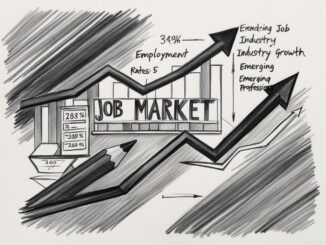
For Gen X professionals navigating today’s job market, finding the right career opportunity is about more than just landing a role—it’s about ensuring the company aligns with your values, work style, and long-term goals. With decades of experience, Gen Xers bring unparalleled expertise to the table, but they also face unique challenges, such as ageism or mismatched workplace cultures. Knowing how to tell if you’re not a fit for a company can save time, reduce stress, and lead to a more fulfilling career move.
Why Fit Matters for Gen X Professionals
Company fit is critical for job satisfaction and career success. According to a 2023 LinkedIn study, 60% of professionals who left jobs cited poor cultural fit as a key reason. For Gen Xers, who often juggle leadership roles, family responsibilities, and a desire for meaningful work, a mismatch can lead to burnout or disengagement. By identifying early signs of a poor fit, you can focus your job search on opportunities that align with your strengths and values.
As a generation that values stability but embraces adaptability, Gen Xers can use their experience to assess companies critically. This guide will explore actionable strategies to evaluate fit, tailored to your unique perspective, while incorporating the keyword how to tell if you’re not a fit for a company to boost searchability.
Step 1: Research the Company Culture
Company culture shapes your day-to-day experience, from collaboration styles to work-life balance. A mismatch here can make even the most exciting job feel draining. For Gen Xers, who often prioritize authenticity and purpose, understanding a company’s culture is non-negotiable.
How to Evaluate Culture
- Check Online Reviews: Platforms like Glassdoor and Indeed offer employee insights. Look for recurring themes, such as “micromanagement” or “supportive leadership.” For example, if reviews mention a “grind culture,” it may clash with your preference for work-life balance.
- Analyze Social Media: Browse the company’s LinkedIn, X, or Instagram for posts about team events or values. A tech startup posting about 24/7 hackathons might not suit a Gen Xer seeking flexibility.
- Look for DEI Commitment: Gen Xers often value inclusive workplaces. Check if the company has diversity initiatives or leadership representation that aligns with your expectations.
Red Flags
- Frequent mentions of high turnover or burnout.
- Vague mission statements that don’t reflect employee experiences.
- Lack of transparency about remote work or flexibility policies.
Example for Gen Xers: If you’re a marketing director who thrives in collaborative settings but Glassdoor reviews describe a “cutthroat” environment, this company may not support your leadership style.
Step 2: Assess the Role’s Demands
A job description can reveal whether a role aligns with your skills and lifestyle. Gen Xers, with their extensive experience, should look for roles that leverage their expertise without overwhelming their capacity.
How to Spot a Mismatch
- Unrealistic Expectations: If the job requires “10+ years of experience” but lists entry-level tasks, it may undervalue your skills. Conversely, a role demanding 60-hour weeks may not suit your work-life balance.
- Skill Misalignment: Compare the job’s requirements to your strengths. For instance, a finance manager role requiring advanced coding skills might not fit if you specialize in budgeting.
- Lack of Growth: Gen Xers often seek roles with impact or leadership potential. If the job offers no clear path for advancement, it could stifle your career.
Red Flags
- Vague or overly broad job descriptions.
- Requirements that don’t match the salary or title.
- No mention of professional development opportunities.
Pro Tip for Gen Xers: Use LinkedIn’s Career Explorer tool to compare your skills with the job’s demands. If the role requires skills you haven’t used in years, it might not be the best fit.
Step 3: Evaluate Leadership and Management Style
As seasoned professionals, Gen Xers often work under or alongside senior leaders. A disconnect with management can make a job unsustainable, especially if you value autonomy or mentorship.
How to Assess Leadership
- Ask About Reporting Structure: During interviews, inquire about your direct manager’s style. For example, “How would you describe your approach to feedback?” A micromanaging boss may frustrate a self-directed Gen Xer.
- Research Leadership: Check LinkedIn profiles of executives. If they lack experience in your industry, they may not value your expertise.
- Observe Communication: Pay attention to how recruiters or interviewers communicate. Dismissive or unclear responses could signal disorganized leadership.
Red Flags
- High turnover in leadership roles (check LinkedIn for tenure).
- Interviewers who dodge questions about team dynamics.
- A culture that prioritizes youth over experience.
Example for Gen Xers: If you’re an IT consultant who excels in strategic roles but the CTO emphasizes hands-on coding, the company may not appreciate your high-level expertise.
Step 4: Gauge Work-Life Balance
Gen Xers often juggle career demands with family or personal commitments. A company that doesn’t respect boundaries can lead to burnout, especially for professionals who’ve learned the value of balance over decades.
How to Evaluate Work-Life Balance
- Ask Direct Questions: In interviews, ask, “How does the team manage workload during peak times?” Answers like “we all pitch in late nights” may signal an always-on culture.
- Check Policies: Look for details on remote work, flexible hours, or vacation policies. Companies that don’t offer flexibility may not suit Gen Xers with established routines.
- Talk to Employees: Connect with current or former employees on LinkedIn. Ask, “How does the company support work-life balance?” Their answers will reveal more than a job posting.
Red Flags
- No clear policies on remote or hybrid work.
- Expectation of constant availability (e.g., answering emails at midnight).
- Reviews mentioning “work hard, play hard” without balance.
Pro Tip for Gen Xers: If you value evenings with family, a company requiring frequent after-hours meetings is a clear mismatch.
Step 5: Align Values and Mission
Gen Xers often seek purpose-driven work, whether it’s mentoring teams or contributing to social impact. A company whose values don’t align with yours can feel unfulfilling, no matter the paycheck.
How to Assess Values
- Read the Mission Statement: Does it resonate with your priorities? For example, a company focused on “disrupting markets” might not suit a Gen Xer who values stability.
- Look for Proof: Check if the company’s actions match its values. If they claim “sustainability” but have no eco-friendly initiatives, it’s a red flag.
- Ask in Interviews: Pose questions like, “How does the company give back to the community?” Vague answers suggest a lack of commitment.
Red Flags
- Mission statements that feel generic or buzzword-heavy.
- No evidence of employee recognition or community involvement.
- Values that clash with your ethics (e.g., aggressive sales tactics).
Example for Gen Xers: If you’re a healthcare administrator who prioritizes patient care but the company focuses solely on profit margins, you’ll likely feel disconnected.
Step 6: Trust Your Gut During Interviews
Interviews are a two-way street. For Gen Xers, who’ve honed their instincts over years, gut feelings can be a powerful indicator of fit. Pay attention to how you feel during the process.
How to Listen to Your Instincts
- Notice Energy: Do you feel energized or drained after interviews? A draining experience may signal a cultural mismatch.
- Assess Respect: Are interviewers respectful of your time and experience? Being rushed or dismissed can indicate how the company values seasoned professionals.
- Reflect on Alignment: After each interview, ask yourself, “Can I see myself thriving here?” If the answer is no, explore why.
Red Flags
- Interviewers who seem unprepared or disinterested.
- A process that feels chaotic or overly drawn-out.
- A gut sense that “something’s off.”
Pro Tip for Gen Xers: Keep a journal of your interview experiences. Note how each company makes you feel to identify patterns of fit or mismatch.
Step 7: Look for Signs of Ageism
Gen Xers sometimes face subtle ageism in hiring, especially in tech-heavy or startup environments. Spotting these signs early can help you avoid toxic workplaces.
How to Identify Ageism
- Job Ads: Be wary of phrases like “digital native” or “recent graduates preferred,” which may prioritize younger candidates.
- Interview Questions: Questions like “Are you comfortable with new technology?” can imply assumptions about your adaptability.
- Team Demographics: If the company’s LinkedIn shows a leadership team entirely under 35, they may undervalue your experience.
Red Flags
- Overemphasis on “youthful energy” in job postings.
- Interviewers who focus on your age rather than skills.
- A lack of Gen X or older employees in visible roles.
Example for Gen Xers: If a startup’s job ad seeks a “culture fit” for a “fun, young team,” it may not welcome the perspective of a seasoned professional.
Step 8: Compare Compensation and Benefits
Compensation isn’t just about salary—it’s about whether the total package supports your lifestyle. Gen Xers, often at peak earning years, should ensure the offer reflects their expertise.
How to Evaluate Offers
- Salary Alignment: Use tools like Glassdoor or Payscale to check if the salary matches industry standards for your experience level.
- Benefits Fit: Look for benefits like 401(k) matching, health insurance, or parental leave that matter to you.
- Long-Term Value: Consider equity, bonuses, or professional development stipends. A low base salary with no growth potential may not be worth it.
Red Flags
- Salaries significantly below market rate for your role.
- Minimal or no benefits for senior positions.
- Reluctance to discuss compensation during interviews.
Pro Tip for Gen Xers: If you’re transitioning to a new industry, a slightly lower salary might be acceptable if the company offers robust training or growth opportunities.
What to Do If You’re Not a Fit
If you determine a company isn’t right for you, don’t despair. Here’s how to move forward:
- Politely Decline: Thank the recruiter for their time and explain you’re seeking a role that better aligns with your goals. This keeps the door open for future opportunities.
- Refine Your Search: Use insights from the experience to narrow your criteria, such as prioritizing flexible hours or collaborative cultures.
- Network Strategically: Connect with Gen X peers on LinkedIn or attend industry events to find companies that value your expertise.
Final Thoughts: Find Your Perfect Fit
Knowing how to tell if you’re not a fit for a company empowers Gen X job seekers to make confident, informed decisions. By researching culture, assessing role demands, and trusting your instincts, you can avoid mismatches and focus on opportunities that align with your values and expertise. With the right approach, you’ll find a company that not only hires you but celebrates the unique perspective you bring as a Gen X professional.
Ready to take control of your job search? Start by researching one company on your list today—check their Glassdoor reviews or LinkedIn posts. If you need personalized advice, connect with me on LinkedIn, and let’s discuss how to find your ideal career fit!



